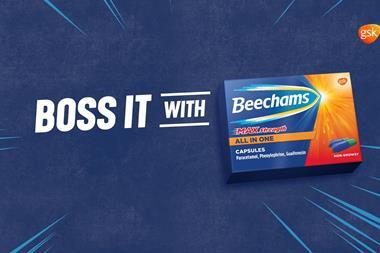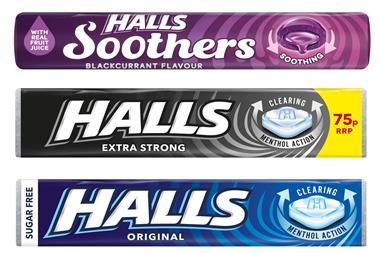Strain on the NHS and shoppers’ busy lives mean that consumers are heading your way to find fast-acting remedies for common ailments.
Thought that over-the-counter medicine wasn’t the sexiest category down at your c-store? Then you obviously haven’t spoken to Debby Deeley, manager at Spar Heskin in Lancashire.
While executing her store’s strategy of presenting paracetamol, condoms and pregnancy tests on a single shelf, Debby saw the chance for a cheeky tweet.
She posted a snap of the display on Twitter, with a caption suggesting that her Spar provided all the essentials couples might need for a romantic night in.
“It was really funny,” she laughs. “I was doing the merchandising on the shop floor, saw what we were putting out, and it just made me giggle. So I thought it would be a nice tweet to put out.”
Joking aside, her re-merchandising was part of the store’s plan to liberate medicines from behind the counter and get them on the shop floor. Debby believes it’s already paying dividends by boosting average basket spend.
“All our stores have been asked to try to provide a basic selection of medicines out on the shop floor, just so people don’t have to ask to get them,” she says.
Perhaps unsurprisingly, Debby finds it’s those more red-cheek provoking products that people prefer to pick off the shelf for themselves.
“In my experience it works really well. To be honest, I’m surprised by how quickly people pick them up when we do it. Bizarrely, it seems to really work for pregnancy testing kits, in particular.
“Perhaps it’s something that people are embarrassed to ask for at the counter. I suppose [like condoms] it’s a private buy for customers, and maybe something you don’t want other people to know about!”
Sexy or not, OTC medicines are still a must-have category for all serious c-stores. According to Mintel, they made up a not-to-be-sniffed-at £1.25bn market in 2017. Plus, as winter sets in, demand will naturally be high among customers coming down with colds and flu.
One big challenge for retailers is picking the right products from a selection so diverse it ranges from pile cream to paracetamol. At some smaller locations it may be smart to have a tightly-edited, compact offer – yet Debby insists that it’s necessary to stock a wide range at her store. “I’m lucky in this store with medicines, since we have a really good range,” she says.
“We’ve got a whole bay of them that go from Savlon, Deep Heat and plasters, right through to painkillers. I think that even if you haven’t got the space we have, you need to stock at least one of all the basic lines. That means all stores should stock painkillers, cold relief and hay fever tablets, at the very least.”
It’s not just important to do during the winter either, says Debby. “Obviously, those kinds of medicines do well from October until spring, but hay fever tablets have done really well this year – especially with the hot summer we’ve just had.”
Whatever you plan to stock in-store, there’s one product it’s impossible to do without: paracetamol. Mintel flags it up as “by far” the most popular OTC analgesic among UK consumers, mainly because of its reputation for being both cheap and fast acting.
Gareth Hooton, from Hooton’s Newsagent (Best One) in Golborne in Wigan, says that (along with ibuprofen) it’s certainly a big win for his store.
“Day to day we tend to sell a lot of the Best-one-branded paracetamol and ibuprofen,” he says. “They’re definitely two of our biggest sellers.
“It’s for when customers don’t feel too bad and they just want to pick something up to keep them going if they have a headache or suffering from a cold.”
Reel them in with Fisherman’s Friend
Consumers don’t always want tablets to tackle the sniffles, they’ll often choose a medicated sweet instead. This makes the category a canny choice to put near the counter.
“Medicated confectionery is widely recognised as a distress purchase and, as such, offers a huge opportunity for convenience store owners to capitalise on impulse sales during the winter cough and cold season,” says Martin Stimson, area business manager for Fisherman’s Friend in the UK.
Stimson explains that c-stores have contributed 44% of all the brand’s sales in 2018 – the largest of any channel. To boost sales further, Fisherman’s Friend will be returning to consumers’ screens in the winter with a £1m burst of TV activity featuring renowned tenor Alfie Boe.
Stimson says that the low price point of the product makes it popular with shoppers who don’t want to splash out on expensive remedies. Plus, there’s the fact that Fisherman’s Friend has a cult following for consumers who relish the distinctive taste of the Original variant.
“Fisherman’s Friend has very high consumer loyalty within the UK, due to the brand’s iconic heritage and the ‘cult-like’ following of the UK’s best-selling flavour, Original Extra Strong, which contains more menthol than competitor brands,” he says.
“At the same time, we’ve introduced a raft of fruity variants over the years to appeal to shoppers who want the benefits of menthol, but with a more subtle, softer flavour, and these are proving increasingly popular.”
Own-brand breakthrough
In the everyday analgesic category, private label and painkillers go together like a cough and a sneeze. This medicine marriage isn’t just about customers being thrifty, either. People increasingly believe that own-brand OTC products work well enough on minor ailments. For example, 67% of adults agree that own-label versions of over-the-counter remedies for treating pains and ailments have the same ingredients as branded ones (Mintel).
Despite this belief, Gareth adds that as their symptoms get more serious, c-store customers are often likely to splash out on the bigger brands.
“It’s funny, because if they’ve just got a headache customers want a cheap paracetamol hit, and to get on with their day,” he says. “But if they’re feeling really down with a cold or flu then they tend to go with a brand. That’s why we do your Lemsips and your Beechams. We get by with a relatively small range, and if customers need anything more we can send them down the chemists.”
Meanwhile, Anita Nye, manager of Eldred Drive Stores, in Orpington, Kent, has a theory that when it comes to their kids, people are also more likely to go for a brand.
“What I see is that if it’s for themselves, people want something cheap,” she says. “When it comes to buying kid’s stuff, they do tend to want the names that they trust: Calpol, and things like that.”
Apart from a keen selection at her store, another reason Debby reckons OTC does well is that the nearest local pharmacy is in the next village. This helps make the c-store a destination for medicines and distress buys for shoppers who don’t want to venture too far from home.
With location in mind, proximity to a pharmacy is often going to inform the number of medicines a retailer chooses to stock. However, Anita says that having one close by hasn’t hobbled her OTC medicine sales overall.
“We have got a chemist near us, but it shuts for a half-day on Saturdays and doesn’t open on Sundays,” she says.
“It opens at nine and closes at six, while we’re open earlier and close much later. That means customers then choose to come to us when it’s shut.”
Anita adds that for everyday OTC buys, shoppers are likely to stick them in the basket while they’re out buying their milk and bread for speed.
“What tends to happen is that customers are in here doing their shopping anyway. So if they want to pick up some painkillers, they just think ‘Well, if we need it, we might as well get it from here right now’.”
At Anita’s store the medicines go at the side of the counter. This keeps them out in full view where customers can pick them up easily, but also helps her protect high-value stock from light fingers.
“It’s there where we can see it,” she says. “We had a refit and wanted the section a bit closer to where we were, just so we could keep an eye on it,” she explains.
One of the more serious reasons sniffle-suffering shoppers will be buying medicines from c-stores this winter is because of the crisis in the NHS.
As severe budget cuts mean that waits for a GP appointment have topped a month in some areas (Mintel), consumers are more likely to self-medicate. This is especially true since the authorities now insist that people don’t go to their GP seeking help for simple cold and flu issues.
“The NHS recommends that winter ailments – such as the common cold – can often be treated without seeing the GP,” says Olbas brand manager Samantha George.
“When feeling under the weather consumers often turn to their local convenience store to pick up over-the-counter remedies to ease their symptoms and help avoid disruption to their daily lives. Convenience stores are therefore in a prime position to serve these needs by stocking a selection of effective OTC remedies.”
Gareth reckons that he’s seen this play out in his local community. “It’s definitely happening at our local doctors,” he says.
“If you don’t phone at a certain part of the day then you won’t get an appointment to see anybody. I can see how this is making it more likely for people to buy their medicines from places such as ours.”
Anita agrees that high demand for GP appointments can drive more shoppers through her doors. But she’s very careful to point out to customers that they’re a c-store, and not qualified pharmacists who can give out advice.
“I think that for a lot of simple conditions, such as a cold or cough, people are probably trying to self-medicate a bit more,” she says.
“You do get customers coming in and asking specific questions about the medicines. But then we point out that they’ll have to go off to talk to someone better qualified about them. We don’t want to offer any advice.”
There’s no danger c-stores are going to turn into pharmacies anytime soon. Yet there’s plenty of scope for brands to come up with fresh ideas to take the convenience medicines market further.
So what’s next for the overall category? As the big names jostle for position on the shelves, with the own-brands nipping at their heels, it can be hard to see where there’s space for any new products. However, Mintel has a canny prediction for what’s coming next.
It believes that in the next few years the biggest driver for OTC analgesics won’t be super-virulent viruses, or ultra-harmful health conditions, it’ll be customers’ lifestyles.
The fact is that we Brits are working harder than ever – and that’s making the population more anxious, driving the race to develop headache products with a stress-busting edge.
Plus, time-poor customers can’t spare a minute to slow down. Mintel reports that 35% of employees on permanent contracts are too busy to rest when they’re ill with a cold or flu.
These twin drivers could boost c-store medicine further. As brands develop stress-busting products for the future, no doubt shoppers will be rushing to pick them up at their local store while on the way to work.
“It’s all about convenience isn’t it?” confirms Gareth. “It’s providing the headache tablets or whatever, right there so customers can come in and get them. Then they don’t need to go anywhere else – that’s what we’re here for.”
Merchandising - The pain-free way to master medicines
With reports of GP waiting rooms being overwhelmed by people with coughs and colds, it’s no surprise that consumers are turning to c-stores for fast-acting remedies instead.
“With a growing and ageing population putting large amounts of stress and pressure onto the NHS, UK consumers are increasingly looking to their local convenience stores for over-the-counter solutions,” says Jo Cooper, sales director of grocery and convenience at GSK.
“This demonstrates a clear opportunity for growth for convenience stores, making it a crucial category for retailers to get right.”
Cooper points out that there are an estimated 57 million GP consultations and 3.7 million visits to A&E every year for self-treatable conditions, which cost the NHS an estimated £2.3bn (PAGB Self Care Report 2017). So with the right range (for minor ailments only), c-stores could actually be saving the NHS money.
“Pain and coughs and colds are among the most frequently suffered ailments and also the most treatable through self-medication,” she says.
“Therefore these categories are the most important for retailers to focus on. GSK brands such as Panadol, Beechams and Piriteze are all easily available over the counter and offer the option for consumers to self-treat conveniently, and further help to ease the burden on the NHS.”
To boost sales Cooper recommends maximising visibility by including visual cues around the store, plus merchandising the category into easily identifiable sub categories. Stocking the best-sellers is also a smart idea.
And although medicines are often a planned buy in-store, there are still plenty of clever ways to increase sales of sniffle-related products.
“Retailers can drive additional impulse sales of complementary products, such as tissues, by creating displays in FSDUs or at the till point to provide the opportunity to upsell,” she says.

























No comments yet